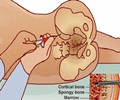
Following up on this breakthrough, the USC team — led by Jing Liu, senior research associate in the laboratory of Andy McMahon — has made the technique simpler and more accessible by engineering a TRAP mouse. When bred with any one of thousands of existing strains of transgenic mice, the TRAP mouse produces progeny with tagged ribosomes in specific organs or cell types.
To demonstrate how useful this can be, Liu and her colleagues used TRAP mice to tag four different types of kidney cells and identify early signals of acute kidney injury.
As a consequence of surgery, infections or drug toxicity, five to seven percent of all hospitalized patients experience acute kidney injury, which can lead to chronic kidney disease or death.
Currently, doctors can only detect acute kidney injury a full day after it occurs. The TRAP mouse enables earlier detection, which will greatly improve patients' health.
"The technology is simple, and the kidney field is very excited about our results," said Liu. "I anticipate that the TRAP mouse will advance our cellular and molecular understanding of a wide variety of diseases and injuries in many different organ systems."
Advertisement
Source-Eurekalert










